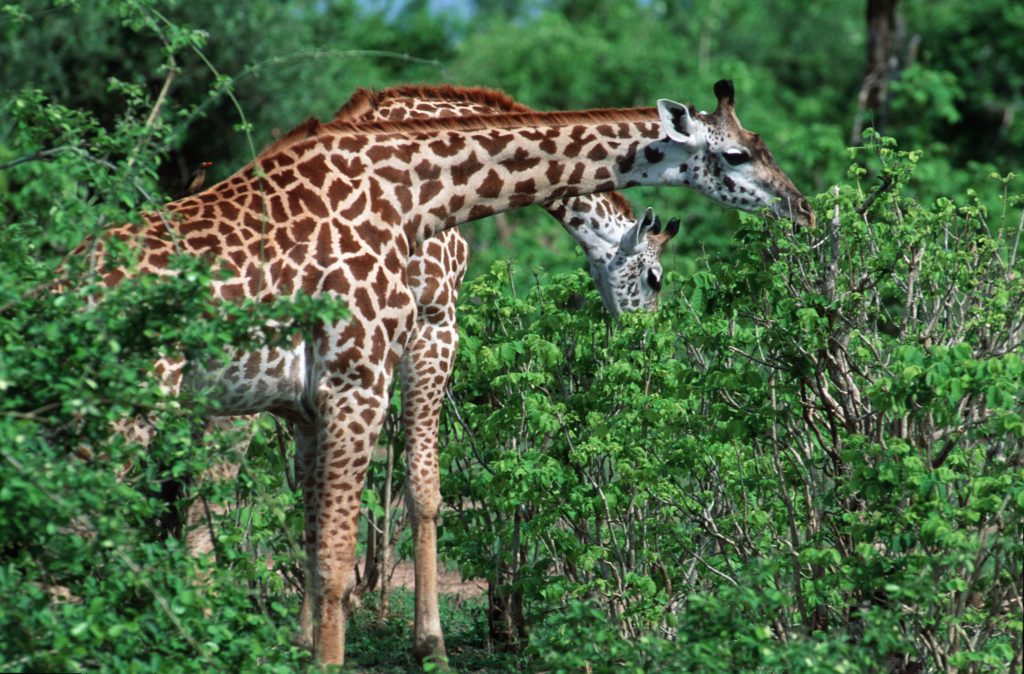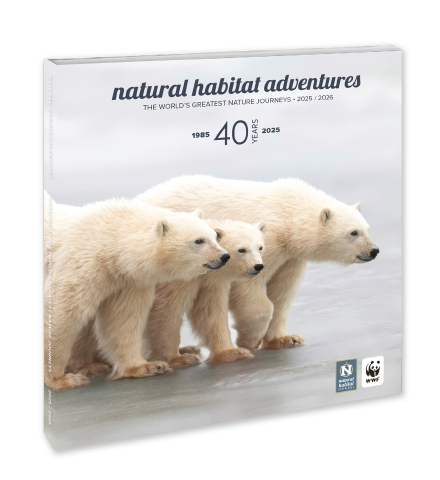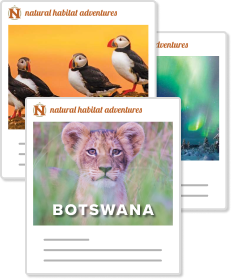Zambia is home to the wildlife of a classic African safari—elephants wandering vast plains, cheetahs stalking silently through the grass and hippos bobbing in rivers. Yet Zambia offers even more: an extraordinary variety of rare and unusual animals found in few other places. Go beyond the familiar safari sightings to uncover the remarkable wildlife diversity of Zambia’s pristine, lesser-known habitats.
The Thornicroft’s giraffe has dark, large leaf-shaped spots traveling down its cream-colored legs. © Roger Leguen/WWF-Canon
1. Thornicroft’s giraffe
Also known as the Rhodesian giraffe, Thornicroft’s giraffe is recognized by its distinctive leaf-like pattern. This unique subspecies, named after former North-Western Rhodesia commissioner Harry Scott Thornicroft, lives exclusively within the Luangwa Valley .
2. Roan antelope
Often mistaken for sable antelope, the roan antelope has a lighter coat and long, powerful horns. Travelers lucky enough to witness territorial disputes will see males drop dramatically to their knees before violently clashing their horns in fierce competition.
Only male pukus possess short, slightly curved horns. © Martin Harvey/WWF-Canon
3. Puku
Zambia is one of the best locations in Africa to observe pukus, medium-sized antelopes noted for their golden-red coats. Herds congregate on floodplains during the dry season, creating a spectacular sight for wildlife enthusiasts.
4. Bushpig
With short legs, a rounded body, long snout and small eyes, the bushpig is an elusive nocturnal species. Typically found in groups of about a dozen, bushpigs forage after dark, offering adventurous travelers a rare nighttime safari encounter.
Crawshay’s zebras have narrower stripes without the brown shadow stripes typical in other subspecies.
5. Crawshay’s zebra
Distinct from other plains zebras, Crawshay’s zebra resides in South Luangwa National Park. This subspecies is marked by narrower black stripes and the absence of the faint, shadowy stripes seen in others.
6. White-tailed mongoose
This is the largest mongoose species, characterized by longer hind legs giving its back a rounded appearance. Primarily solitary and nocturnal, travelers might spot or hear this mongoose on evening game drives. It’s also known for its skunk-like odor used as a defense mechanism.
Wildlife experts hypothesize lions climb trees to avoid biting insects in the grasses below. © Mark Hickey
7. Tree-climbing lions
In Kafue National Park, lions exhibit the unusual behavior of resting high in fig trees. Witnessing lions lounging on branches is both an extraordinary wildlife sighting and a photographer’s dream.
8. Lichtenstein’s hartebeest
This large antelope is recognizable by its high shoulders, yellow-brown coat and distinctively curved horns forming an “S” shape. Both males and females have these unique horns, making identification easier during safaris.
The name pangolin comes from the Malay word “pengguling,” roughly meaning “something that rolls up.” © John E. Newby/WWF-Canon
9. Pangolin
Though sightings are challenging due to their shy and nocturnal nature, pangolins can occasionally be spotted in Kafue National Park. Known as the “scaly anteater,” pangolins protect themselves by curling into a tight, armored ball when threatened.
10. Cookson’s wildebeest
This subspecies of wildebeest, found only in Luangwa Valley, is smaller than its cousins. Easily identified by distinct, reddish bands running down its sides, Cookson’s wildebeest provides a unique wildlife viewing experience.
Discover Zambia’s extraordinary wildlife on safari with WWF and Natural Habitat Adventures .
By Marsea Nelson, WWF guest blogger
Request Your 2025/2026 Catalog
Discover the World's Best
Nature Travel Experiences
Together, Natural Habitat Adventures and World Wildlife Fund have teamed up to arrange nearly 100 nature travel experiences around the planet, while helping to protect the magnificent places we visit and their wild inhabitants.
Discover the World's Best
Nature Travel Experiences
Our weekly eNewsletter highlights new adventures, exclusive offers, webinars, nature news, travel ideas, photography tips and more. Sign up today!
Hidden form View
Home Trips Trips Catalog Catalog Contact Contact More More Have a question or comment? Hours Mountain Time
×
Home
Trips
Trips
Catalog
Catalog
Book
Contact
Contact
More
More
[ebook-modal-wrapper]
[ebook-modal-wrapper]
[full-width-start]
[full-width-start]
[full-width-end]
[full-width-end]
[aside-height-start]
[aside-height-start]
[aside-height-end form-start]
[aside-height-end form-start]
[aside-content-start aside-text-start]
[aside-content-start aside-text-start]
[aside-text-end]
[aside-text-end]
[aside-image-start]
[aside-image-start]
[aside-image-end aside-content-end]
[aside-image-end aside-content-end]
[content-start subheader-start]
[content-start subheader-start]
[subheader-end main-header-start]
[subheader-end main-header-start]
[main-header-end image-height-start]
[main-header-end image-height-start]
[image-height-end content-end]
[image-height-end content-end]
[ebook-header-optin]
[ebook-header-optin]
[ebook-subheader-optin]
[ebook-subheader-optin]
[ebook-aside-image]
[ebook-aside-image]
[ebook-aside-text]
[ebook-aside-text]
[ebook-logos]
[ebook-logos]
[form-header-start]
[form-header-start]
[form-header-end form-start]
[form-header-end form-start]
[ebook-header-form]
[ebook-header-form]
[privacy-policy]
[privacy-policy]
[ebook-form-sms-text-wrapper]
[ebook-form-sms-text-wrapper]
[ebook-sms-privacy-wrapper]
[ebook-sms-privacy-wrapper]
[ebook-sms-fine-print]
[ebook-sms-fine-print]
[ebook-submit-button]
[ebook-submit-button]
[ebook-header-success]
[ebook-header-success]
[ebook-success-text]
[ebook-success-text]
[thank-you-start]
[thank-you-start]
[thank-you-end link-text-start]
[thank-you-end link-text-start]
[link-text-end]
[link-text-end]
[aside-start]
[aside-start]
[aside-end form-start]
[aside-end form-start]
[content-start]
[content-start]
[content-end]
[content-end]
[aside-content-start aside-image-start]
[aside-content-start aside-image-start]
[aside-image-end]
[aside-image-end]
[aside-text-start logos-start]
[aside-text-start logos-start]
[aside-text-end logos-end aside-content-end]
[aside-text-end logos-end aside-content-end]
[subheader-start]
[subheader-start]
[main-header-end aside-image-start aside-text-start]
[main-header-end aside-image-start aside-text-start]
[aside-text-end logos-start]
[aside-text-end logos-start]
[aside-image-end logos-end]
[aside-image-end logos-end]
[ebook-modal-wrapper]
[ebook-modal-wrapper]
[full-width-start]
[full-width-start]
[full-width-end]
[full-width-end]
[aside-height-start]
[aside-height-start]
[aside-height-end form-start]
[aside-height-end form-start]
[aside-content-start aside-text-start]
[aside-content-start aside-text-start]
[aside-text-end]
[aside-text-end]
[aside-image-start]
[aside-image-start]
[aside-image-end aside-content-end]
[aside-image-end aside-content-end]
[content-start subheader-start]
[content-start subheader-start]
[subheader-end main-header-start]
[subheader-end main-header-start]
[main-header-end image-height-start]
[main-header-end image-height-start]
[image-height-end content-end]
[image-height-end content-end]
[ebook-header-optin]
[ebook-header-optin]
[ebook-subheader-optin]
[ebook-subheader-optin]
[ebook-aside-image]
[ebook-aside-image]
[ebook-aside-text]
[ebook-aside-text]
[ebook-logos]
[ebook-logos]
[form-header-start]
[form-header-start]
[form-header-end form-start]
[form-header-end form-start]
[ebook-header-form]
[ebook-header-form]
[privacy-policy]
[privacy-policy]
[ebook-form-sms-text-wrapper]
[ebook-form-sms-text-wrapper]
[ebook-sms-privacy-wrapper]
[ebook-sms-privacy-wrapper]
[ebook-sms-fine-print]
[ebook-sms-fine-print]
[ebook-submit-button]
[ebook-submit-button]
[ebook-header-success]
[ebook-header-success]
[ebook-success-text]
[ebook-success-text]
[thank-you-start]
[thank-you-start]
[thank-you-end link-text-start]
[thank-you-end link-text-start]
[link-text-end]
[link-text-end]
[aside-start]
[aside-start]
[aside-end form-start]
[aside-end form-start]
[content-start]
[content-start]
[content-end]
[content-end]
[aside-content-start aside-image-start]
[aside-content-start aside-image-start]
[aside-image-end]
[aside-image-end]
[aside-text-start logos-start]
[aside-text-start logos-start]
[aside-text-end logos-end aside-content-end]
[aside-text-end logos-end aside-content-end]
[subheader-start]
[subheader-start]
[main-header-end aside-image-start aside-text-start]
[main-header-end aside-image-start aside-text-start]
[aside-text-end logos-start]
[aside-text-end logos-start]
[aside-image-end logos-end]
[aside-image-end logos-end]
[ebook-modal-wrapper]
[ebook-modal-wrapper]
[ebook-background-image]
[ebook-background-image]
[ebook-header-optin]
[ebook-header-optin]
[ebook-subheader-optin]
[ebook-subheader-optin]
[privacy-policy]
[privacy-policy]
[ebook-form-sms-text-wrapper]
[ebook-form-sms-text-wrapper]
[ebook-sms-privacy-wrapper]
[ebook-sms-privacy-wrapper]
[ebook-sms-fine-print]
[ebook-sms-fine-print]
[ebook-submit-button]
[ebook-submit-button]
[ebook-header-success]
[ebook-header-success]
[ebook-success-text]
[ebook-success-text]
[full-width-start]
[full-width-start]
[full-width-end]
[full-width-end]
[image-height-start]
[image-height-start]
[image-height-end content-start]
[image-height-end content-start]
[content-end]
[content-end]
[content-start subheader-start]
[content-start subheader-start]
[subheader-end main-header-start]
[subheader-end main-header-start]
[main-header-end form-start]
[main-header-end form-start]
[form-end content-end]
[form-end content-end]
[full-width-start logos-start]
[full-width-start logos-start]
[image-height-start logos-start]
[image-height-start logos-start]
[logos-start]
[logos-start]
[logos-end content-start]
[logos-end content-start]
[full-height-start]
[full-height-start]
[logos-start content-start]
[logos-start content-start]
[logos-end content-end full-height-end]
[logos-end content-end full-height-end]
[main-header-start]
[main-header-start]
[main-header-end subheader-start]
[main-header-end subheader-start]
[subheader-end form-start]
[subheader-end form-start]
[thank-you-start]
[thank-you-start]
[thank-you-end link-text-start]
[thank-you-end link-text-start]
[link-text-end]
[link-text-end]
[ebook-modal-wrapper]
[ebook-modal-wrapper]
[ebook-background-image]
[ebook-background-image]
[ebook-header-optin]
[ebook-header-optin]
[ebook-subheader-optin]
[ebook-subheader-optin]
[privacy-policy]
[privacy-policy]
[ebook-form-sms-text-wrapper]
[ebook-form-sms-text-wrapper]
[ebook-sms-privacy-wrapper]
[ebook-sms-privacy-wrapper]
[ebook-sms-fine-print]
[ebook-sms-fine-print]
[ebook-submit-button]
[ebook-submit-button]
[ebook-header-success]
[ebook-header-success]
[ebook-success-text]
[ebook-success-text]
[full-width-start]
[full-width-start]
[full-width-end]
[full-width-end]
[image-height-start]
[image-height-start]
[image-height-end content-start]
[image-height-end content-start]
[content-end]
[content-end]
[content-start subheader-start]
[content-start subheader-start]
[subheader-end main-header-start]
[subheader-end main-header-start]
[main-header-end form-start]
[main-header-end form-start]
[form-end content-end]
[form-end content-end]
[full-width-start logos-start]
[full-width-start logos-start]
[image-height-start logos-start]
[image-height-start logos-start]
[logos-start]
[logos-start]
[logos-end content-start]
[logos-end content-start]
[full-height-start]
[full-height-start]
[logos-start content-start]
[logos-start content-start]
[logos-end content-end full-height-end]
[logos-end content-end full-height-end]
[main-header-start]
[main-header-start]
[main-header-end subheader-start]
[main-header-end subheader-start]
[subheader-end form-start]
[subheader-end form-start]
[thank-you-start]
[thank-you-start]
[thank-you-end link-text-start]
[thank-you-end link-text-start]
[link-text-end]
[link-text-end]
[ebook-modal-wrapper]
[ebook-modal-wrapper]
[ebook-background-image]
[ebook-background-image]
[ebook-header-optin]
[ebook-header-optin]
[ebook-subheader-optin]
[ebook-subheader-optin]
[privacy-policy]
[privacy-policy]
[ebook-form-sms-text-wrapper]
[ebook-form-sms-text-wrapper]
[ebook-sms-privacy-wrapper]
[ebook-sms-privacy-wrapper]
[ebook-sms-fine-print]
[ebook-sms-fine-print]
[ebook-submit-button]
[ebook-submit-button]
[ebook-header-success]
[ebook-header-success]
[ebook-success-text]
[ebook-success-text]
[full-width-start]
[full-width-start]
[full-width-end]
[full-width-end]
[image-height-start]
[image-height-start]
[image-height-end content-start]
[image-height-end content-start]
[content-end]
[content-end]
[content-start subheader-start]
[content-start subheader-start]
[subheader-end main-header-start]
[subheader-end main-header-start]
[main-header-end form-start]
[main-header-end form-start]
[form-end content-end]
[form-end content-end]
[full-width-start logos-start]
[full-width-start logos-start]
[image-height-start logos-start]
[image-height-start logos-start]
[logos-start]
[logos-start]
[logos-end content-start]
[logos-end content-start]
[full-height-start]
[full-height-start]
[logos-start content-start]
[logos-start content-start]
[logos-end content-end full-height-end]
[logos-end content-end full-height-end]
[main-header-start]
[main-header-start]
[main-header-end subheader-start]
[main-header-end subheader-start]
[subheader-end form-start]
[subheader-end form-start]
[thank-you-start]
[thank-you-start]
[thank-you-end link-text-start]
[thank-you-end link-text-start]
[link-text-end]
[link-text-end]
[ebook-modal-wrapper]
[ebook-modal-wrapper]
[ebook-background-image]
[ebook-background-image]
[ebook-header-optin]
[ebook-header-optin]
[ebook-subheader-optin]
[ebook-subheader-optin]
[privacy-policy]
[privacy-policy]
[ebook-form-sms-text-wrapper]
[ebook-form-sms-text-wrapper]
[ebook-sms-privacy-wrapper]
[ebook-sms-privacy-wrapper]
[ebook-sms-fine-print]
[ebook-sms-fine-print]
[ebook-submit-button]
[ebook-submit-button]
[content-start main-header-start]
[content-start main-header-start]
[main-header-end subheader-start]
[main-header-end subheader-start]
[subheader-end content-end]
[subheader-end content-end]
[ebook-header-success]
[ebook-header-success]
[ebook-success-text]
[ebook-success-text]
[full-width-start]
[full-width-start]
[full-width-end]
[full-width-end]
[image-height-start]
[image-height-start]
[image-height-end content-start]
[image-height-end content-start]
[content-end]
[content-end]
[content-start subheader-start]
[content-start subheader-start]
[subheader-end main-header-start]
[subheader-end main-header-start]
[main-header-end form-start]
[main-header-end form-start]
[form-end content-end]
[form-end content-end]
[full-width-start logos-start]
[full-width-start logos-start]
[image-height-start logos-start]
[image-height-start logos-start]
[logos-start]
[logos-start]
[logos-end content-start]
[logos-end content-start]
[full-height-start]
[full-height-start]
[logos-start content-start]
[logos-start content-start]
[logos-end content-end full-height-end]
[logos-end content-end full-height-end]
[main-header-start]
[main-header-start]
[subheader-end form-start]
[subheader-end form-start]
[thank-you-start]
[thank-you-start]
[thank-you-end link-text-start]
[thank-you-end link-text-start]
[link-text-end]
[link-text-end]
[ebook-modal-wrapper]
[ebook-modal-wrapper]
[ebook-background-image]
[ebook-background-image]
[ebook-header-optin]
[ebook-header-optin]
[ebook-subheader-optin]
[ebook-subheader-optin]
[privacy-policy]
[privacy-policy]
[ebook-form-sms-text-wrapper]
[ebook-form-sms-text-wrapper]
[ebook-sms-privacy-wrapper]
[ebook-sms-privacy-wrapper]
[ebook-sms-fine-print]
[ebook-sms-fine-print]
[ebook-submit-button]
[ebook-submit-button]
[ebook-header-success]
[ebook-header-success]
[ebook-success-text]
[ebook-success-text]
[full-width-start]
[full-width-start]
[full-width-end]
[full-width-end]
[image-height-start]
[image-height-start]
[image-height-end content-start]
[image-height-end content-start]
[content-end]
[content-end]
[content-start subheader-start]
[content-start subheader-start]
[subheader-end main-header-start]
[subheader-end main-header-start]
[main-header-end form-start]
[main-header-end form-start]
[form-end content-end]
[form-end content-end]
[full-width-start logos-start]
[full-width-start logos-start]
[image-height-start logos-start]
[image-height-start logos-start]
[logos-start]
[logos-start]
[logos-end content-start]
[logos-end content-start]
[full-height-start]
[full-height-start]
[logos-start content-start]
[logos-start content-start]
[logos-end content-end full-height-end]
[logos-end content-end full-height-end]
[main-header-start]
[main-header-start]
[main-header-end subheader-start]
[main-header-end subheader-start]
[subheader-end form-start]
[subheader-end form-start]
[thank-you-start]
[thank-you-start]
[thank-you-end link-text-start]
[thank-you-end link-text-start]
[link-text-end]
[link-text-end]

































You say that some experts say that lions climb trees to avoid biting insects. Interesting. Do you have any references?